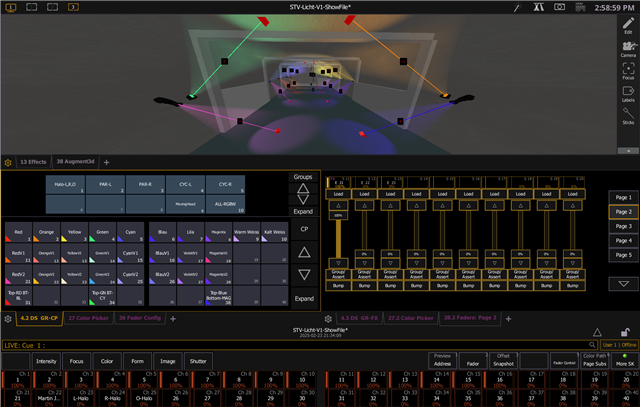
Here a short preview of my show-busking attached under the Mediafire Link.
Link: www.mediafire.com/.../STV-Licht-V1-ShowFile_2025-02-24_15-01-27.esf3d
Hello,
This is my first experience with light busking (the light busking is for an Party with an DJ), and I am currently uncertain about potential improvements or significant structural mistakes I might have made in my setup. When digitally controlling the show and lighting via my ETC Element lighting desk and Augment3D, I consistently encounter im to slow due to timing issues within the effect steps.
My current fader setup is structured as follows:
• Fader Page 2: Includes color faders (Absolute Effect Faders for animated color presets and standard faders for static colors), assigned to S11-13 and S18-20.
• Fader Page 3: Dedicated to main effect faders (S21-26).
• Fader Page 4: Designed for strobe and "hype" effects typically utilized for drops (S31-35).
This setup is still a work-in-progress, though I have endeavored to optimize it to the best of my ability. Please disregard the two moving heads in the center of the Augment3D setup; they are reserved for later integration.
Additionally, I have the following questions:
1. Global Strobe Control: Is there a recommended method to configure a global strobe fader to regulate strobe speed progressively from 0% (off) to approximately 33Hz at 100%? Ideally, the transition should be gradual rather than instantaneous. Would it be advisable to implement this using a basic effect paired with an effect fader featuring a rate function? Currently, I manage this via Companion on a Stream Deck, but it remains suboptimal due to frequent command-line congestion, reducing responsiveness.
2. Effect Speed Control: Is there a superior approach for managing the speeds of various effects? While I appreciate the tap function, its limitation lies in its global application. A global tap button would be highly beneficial; however, previewing individual effect speeds before implementation would be even more advantageous. Currently, Companion via Stream Deck is my method, though the same limitations regarding responsiveness persist.
3. MIDI Integration (Akai MPD226): I possess an Akai MPD226 controller, which could potentially aid in this process. However, I have yet to fully understand or effectively integrate MIDI functionalities. Could leveraging MIDI resolve some of the issues described above, and if so, how might I best approach this integration?
4. Effect Activation Delay: Lastly, I have observed that effect faders, when engaged, do not activate instantly; there is typically a delay of approximately 0.5 to 1 second (e.g., observed with fader S24). Could there be a specific reason for this delay, and how might it be minimized or eliminated? And why do the Effect faders dont work on the Animated-Color Effect Faders?
Thank you in advance for your insights and recommendations.


